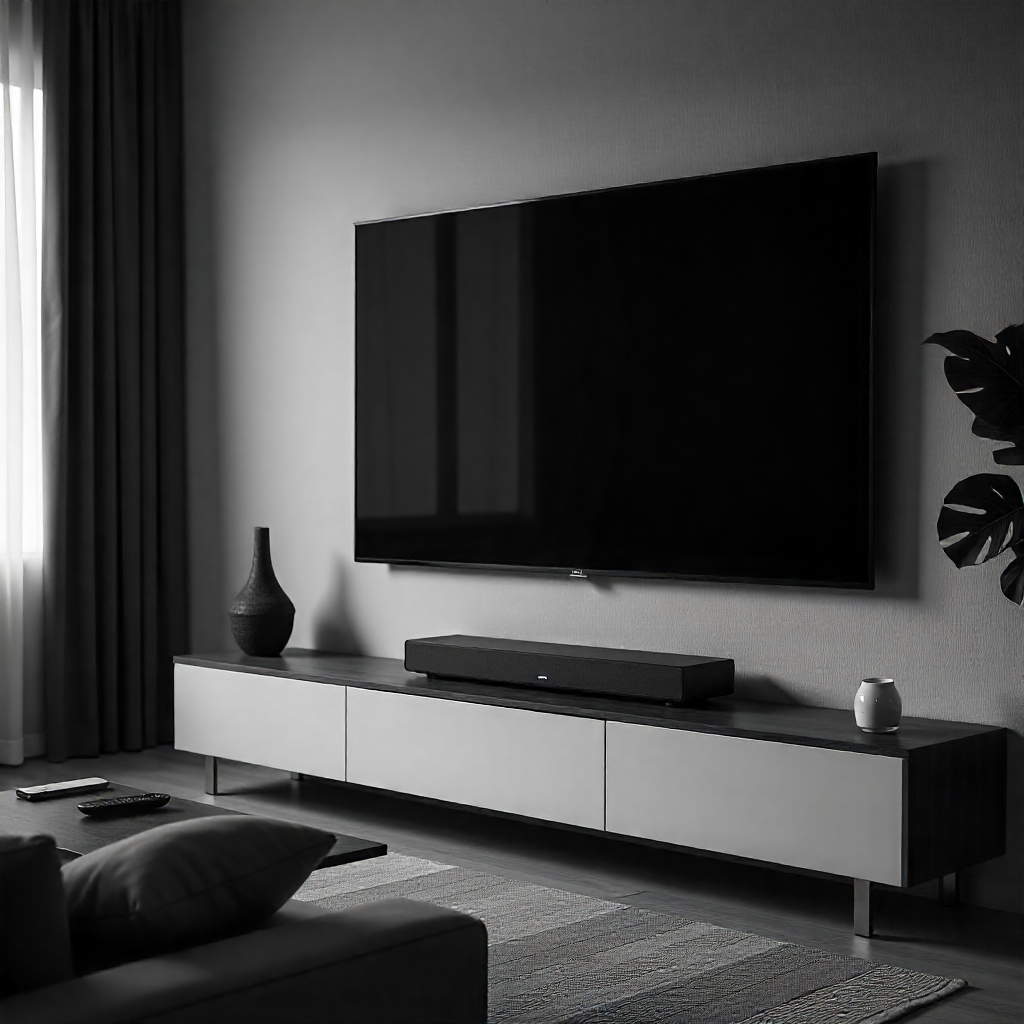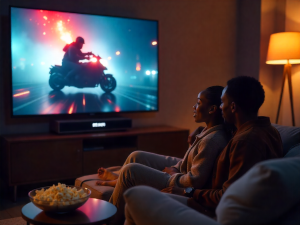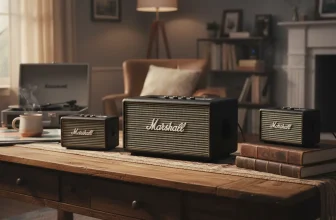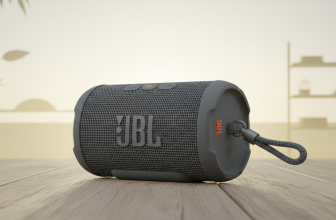
I want to tell one small story. I recently sat down to watch a high-action movie on my new flat-screen TV. The visuals? Stunning. The sound? Needless to say, it was as if the pursuit was being filmed from inside a cardboard box. My Bluetooth speaker television was beautiful, but its speakers sounded wimpier than a phone notification at 6 in the morning.
That’s when I found out the power of a Bluetooth speaker and television. All of a sudden, every explosion shook the room (in a good way), while whispered dialogue was crystal clear. It’s been all forward since then.
In this guide, I’ll explain all you need to know about connecting a Bluetooth speaker to your TV: Why it’s beneficial, how to do it, and the common roadblocks you might encounter. By the end, you’ll have a gauge as to whether it’s a good move for your own living room, and how to pull off the trick seamlessly.
View Details On Amazon
What You’ll Learn in This Guide:
- Why do TV speakers usually sound bad?
- The advantages of connecting your television to a Bluetooth speaker
- How to connect Bluetooth speakers to various TVs
- Pros and cons of Bluetooth vs. wired connections
- Regular things to try that might save you a headache.
- Best speakers for various budgets – recommended speaker types and brands
Why Bluetooth Speaker Television Beats Regular TV Speakers
Let’s face it: modern TVs are like supermodels. They’re slim, mean, and look amazing on your wall. But you can’t exactly expect a 1-inch snap frame to house powerful, high-quality speakers. Plus, without even getting into the fact that there’s no room for full-range drivers that can produce deep bass or crisp highs.
A Consumer Reports study found that more than 70 percent of TV shoppers are unhappy with the sound quality of their built-in speakers. The most common complaints? No flat audio, muddy dialogue, and nothing in the way of bass impact.
That’s why increasing numbers of people are going in for Bluetooth speaker television setups — it’s as if you’re finally giving your TV a voice that matches its appearance.
Advantages of Connecting a Bluetooth Speaker with Your Television
Here’s why the ability to connect your Bluetooth speaker is a game-changer:
Immersive Sound Without the Wires
Nobody loves cables snaking across the living room. Bluetooth eliminates cable clutter to place your speaker anywhere, and you can keep your phone nearby to use all your favorite apps.
Flexible and Portable
When you’re not watching TV, that same speaker can blast Spotify while you cook or take it outside for a barbecue. Do that with a wired soundbar.
Better Dialogue Clarity
Nothing ruins movie night like rewinding three times to figure out why the character has murder in his heart. (And a fine Bluetooth speaker, so you can actually hear the dialogue without turning the volume up to “angry neighbor.”)
Budget-Friendly Upgrade
Not quite ready to invest in a complete home theater setup? A Bluetooth speaker is an inexpensive upgrade from the wimpy sound of a TV.
How to Connect a Bluetooth Speaker to Your Television?
Hooking up a Bluetooth speaker to your TV isn’t rocket science — but it can seem not very safe if you’ve never done it before. It’s a slightly different process at “Samsung” and other TV brands, but here’s a step-by-step guide that has the same road map with some more detail (and pro tips) to make sure you nail it the first time.
Step 1: See If Your TV Has Bluetooth
The vast majority of today’s smart TVs — Samsung, LG, Sony, TCL, Hisense, and Vizio among them — make Bluetooth (wireless connection) as easy as being connected to Wi-Fi.
Here’s how you can check:
- Samsung TVs: Settings > Sound > Sound Output. If you see Bluetooth Speaker List, then your TV supports wireless or Bluetooth headphone connection.
- LG TVs: Go to Settings > Sound > Sound Out > Bluetooth Device List.
- Sony TVs (Android/Google): Settings > Remote & Accessories>Add Accessory.
- TCL (Roku TVs): Most models have Bluetooth for headphones, but not speakers. You will also either need a Roku Wireless Speaker or a transmitter.
If your TV doesn’t have Bluetooth, all is not lost. You can turn your TV into a Bluetooth one with a transmitter (which will either connect to the 3.5mm headphone jack or double as an RCA or optical audio output). They cost about $20 to $30 and will work with virtually any speaker.
Step 2: Make Your Speaker Discoverable (or Pairing Mode)
All Bluetooth speakers can be paired. It’s typically a small button that has an icon of Bluetooth on it.
- Normal procedure: Press the button for 2–5 seconds and make sure it blinks (it is usually white or blue flashing).
- Voice Prompts: A few speakers (JBL, Bose) will read aloud “Pairing mode,” so you won’t be left in the dark.
- Older Models: It may vary by brand and model; try a double press or see the owner’s manual—a menu command could be the activation cue, too.
Give the speaker a few feet of clearance (within about 3 feet) when pairing. Power Rolling Stone Bluetooth performs best at the minimum range on a line-of-sight setup.
Step 3: Connect Via Your TV Settings
Now pull out your remote and dive into the settings:
- Open your TV’s Settings menu.
- Navigate to Sound or Connections.
- Choose Bluetooth or Bluetooth Speaker List.
- Select your speaker’s name from the list (for example, “JBL Flip 5” or “Bose Revolve+”).
- Confirm the connection.
If you did it right, your TV will send all of its audio through the Bluetooth speaker. To test it, simply play a YouTube video or Netflix trailer — boom, you have a rapid and easy sound check.
Step 4: COMPILE Latency Settings
This is the step that people forget.
Ever seen someone’s lips move before the words came? That’s latency, and it’s a fact of life for over-the-air Bluetooth audio.
- Samsung TVs: Settings > Sound > Expert Settings > Digital Audio Delay.
- LG TVs: Settings > Sound > AV Sync Adjust (Auto Sync would also be supported in the low-latency system).
- Sony TVs: Settings > Display & Sound > Audio Output > A/V Sync.
Chinese voices are also arranged on the lips precisely. It takes a couple of tries (typically 2 — 3) to get it set, but once you do that, then you’re good to go.
Some newer TVs and speakers, for instance, have the aptX Low Latency codec that brings lag down to effectively zero. If you watch a ton of live sports or games on a console, this feature is one to check before buying a speaker.
Extra Notes for Specific Users
For Gamers: If you’re a PlayStation or Xbox player, Bluetooth audio could be too laggy. A soundbar with a wire or speakers with HDMI ARC/eARC may be a better option.
For Movie Buffs: If you’re concerned about that cinematic surround sound, one portable speaker isn’t going to beat a combo of soundbar + sub. But it’s still far better than regular built-in TV speakers.
For Multi-Use Speakers: If you want to use your Bluetooth speaker for more than just your TV, such as online streaming and calls from your phone, you’ll want multi-point pairing (so you don’t have to keep reconnecting every time).
Install a Bluetooth speaker for TV connection. Once you understand what’s going on with your TV’s menu structure, the process of setting up a Bluetooth speaker is simple. By adding just a few tweaks, you’ll be able to turn flat, tinny TV sound into a delectable and immersive experience — without leaving behind a bloated cable bill in your living room.
The Pros Of Using Bluetooth For TV Audio
Easy Setup
Connecting your Bluetooth speakers to a TV is easy and intuitive. No ugly wires, no extra drilling holes in your wall. Just turn on Bluetooth, pair the devices, and you’re ready to roll.
Wireless Freedom
The biggest advantage is mobility. And you can put your speaker just about anywhere in the room, on a shelf, coffee table, or even in the kitchen while you’re cooking. Keep your living room clutter-free and cable-free.
Portability
Wireless speakers aren’t anchored to a single place, as wired speakers or sound bars are. When you’re not using it for the TV, you can take it into the backyard, bring it along during a trip, or use it at a house party. One device, multiple uses.
Budget-Friendly Upgrade
Some people have no desire to invest in a complete surround sound system. A secondary Bluetooth speaker is a more budget-friendly means of significantly upgrading sound quality without emptying your pockets.
The Cons of Using Bluetooth for TV Sound
Sound Compression
Bluetooth is lossy, so you won’t get quite the same richness and depth as with a wired HDMI or optical connection. For most people, the gap isn’t enormous, but audiophiles won’t be able to avoid it.
Audio Latency (Delay)
For many, the main drawback is ever-so-slight out-of-sync audio. If you are watching movies or shows, you most likely won’t see a difference. But people wanting to watch live sports or gaming might find even a half-second latency level irritating.
Limited Compatibility
Not all TVs are equipped with Bluetooth. If you do, then you have to go get yourself a Bluetooth transmitter — more money and an extra thing with which to contend.”
Battery Dependency
Most Bluetooth speakers are battery-powered and portable. And if you forget to charge them before movie night, you could be forced to watch with weak or no sound until they’re once again plugged into the wall.
Bluetooth is great if you are looking for convenience, portability, and a wire-free home. But if you’re a stickler for the highest-quality sound and zero lag, especially in sports, gaming, or hi-fi music wirelessly, then a wired connection is still the surefire winner.
Common Bluetooth Speaker Television Problems (And Solutions)
Despite all that elegance between the lines when it comes to technology, Bluetooth connections can act more like a moody teenager than a proper functioning adult — working smoothly one minute only to sulk in stubborn malfunctioning software the next. Don’t worry, though. Most problems are easily resolved when you know where to look. Here’s how to address some of the most common issues:
No Audio From the Speaker
This is the No. 1 freak-out moment. You’ve paired everything, the speaker says “connected,” but no sound.
- First, access your TV’s Sound Settings and ensure the audio output is set to Bluetooth (the system defaults back to “TV Speakers” when you turn it off and on again).
- And make sure your Bluetooth speaker isn’t muted or on the lowest volume level. Yup, it is more common than you might suspect.
- If you are using a Bluetooth transmitter, make sure it is connected to the proper audio port while playing (optical or headphone jack).
Do not think that it is broken; assume 9 times out of 10 that you have some simple setting wrong.
Laggy Audio (The Lip-Sync Problem)
Nothing’s more obnoxious than watching someone’s lips open and close a second before you hear the words. That’s audio latency, and it is a common fluke with Bluetooth.
- If your TV offers an AV Sync setting, you can adjust the audio delay in the menu, which may fix syncing problems. It’s generally solved with small adjustments (to the tune of milliseconds).
- Enable aptX Low Latency if both your speaker and TV support it. This codec reduces lag dramatically.
- If you’re moving to live sports or gaming, flip over to a wired connection when absolute accuracy counts.
One hiccup doesn’t ruin a binge night. Covered that already – once you get sync set right, you typically never have to touch it again.
Check Latest Price
Speaker Won’t Connect at All
This one can seem like Bluetooth treachery. Your speaker is not recognized by your TV or won’t pair.
- Restart both devices. And yes, the classic “turn it off and on again” is still magic.
- Delete/forget the device from within your TV’s Bluetooth menu and try pairing again from scratch.
- Ensure that the speaker isn’t already connected to another device (such as your phone). Unplug it there before you marry it to your TV.
- Keep the speaker near during the setup — Bluetooth range problems can come into play if it is too distant.
Think of it as introducing two friends — sometimes you have to introduce them again and again until the connection happens.
Volume Too Low or Too Quiet
You’ve maxed out the speaker, but it’s still sounding weak.
- Verify if the TV volume and speaker volume can be adjusted differently. A lot of TVs send Bluetooth out as a static (or “line”) level, in which case you control the volume on the speaker.
- Explore your TV’s Expert Sound Settings, if it offers them, and check for an option like Dynamic Range Control or Sound Mode — disabling them might give you a volume boost.
- A few older TVs limit volume before Bluetooth. If so, then you might need to switch to a Bluetooth transmitter with separate volume adjustment.
Before you decide the speaker is “weak,” consider that it might be stuck in a TV. It can make a big difference with a change of settings.
Interference or Sound Cutting Out
The audio quality can be hit or miss, especially while you’re on the go.
- For the best connection, keep your speaker and TV within 10 feet.
- Finally, try not to position Wi-Fi routers, microwaves, or other Bluetooth devices directly between them—it’ll get in the way of the signal.
- If your speaker supports Bluetooth 5.0 or better, take advantage of that. It is more stable than its predecessors.
Bluetooth is wireless, but it’s not voodoo. A direct path of sight usually equates to a direct line of sound.
These are the kind of quick fixes that will keep you from dialing tech support or chucking your remote at the wall. Most problems you encounter between your Bluetooth speakers and TV are the kind of things that can be resolved quickly if you know what to do.
Best Bluetooth Speaker for Television (2025 Models)
There are so many available that shopping for the right Bluetooth speaker to pair with your TV can feel overwhelming. There are hundreds to choose from, and they all promise “powerful bass” and “cinematic sound.” But not all the sound that comes out of a speaker really improves your Netflix nights, football weekends, or family movie marathons.
To spare you the hassle, I’ve sifted through a few real-world favorites (as well as a wish or two) for 2025. Each pick is bound to fit your needs, budget, and lifestyle differently — because, well, the speaker you want at a backyard barbecue isn’t going to be the same one as your Saturday night movie binge.
Budget-Friendly Pick: Anker Soundcore Motion+
If you don’t want to spend a fortune but want better sound from your TV, this is a good place to start.
- Why it’s great for TV: The Soundcore Motion+ has surprisingly clear mids and highs, so dialogue sounds crisp — even when characters are mumbling (I’m looking at you, Batman).
- Bass performance: Don’t expect it to rattle the floorboards, but for a small speaker, it delivers a decent amount of wallop.
- Additional bonuses: It also serves as a portable Bluetooth speaker for picnics or working from the balcony. With a battery life of about 12 hours, you won’t have to keep adding charge in the middle of that movie.
If you’re dipping your toes into the world of Bluetooth speakers and you don’t want to spend too much, it’s a good place to start. It’s the equivalent of stepping up from instant coffee to a real espresso — inexpensive but decidedly better.
Mid-Range Pick: JBL Charge 5
This one’s a crowd-pleaser, and it’s one of my favorites.
- Why it’s great for TV: The JBL Charge 5 is louder and fiercer than the majority of speakers in its price range. Explosions, car chases, and live sports commentary all sound bigger and bolder.
- Bass response: Boy, this thing really loves the lows. If you watch action movies, concerts on DVD, or the like, then you’ll feel the thump.
- Bonus features: Waterproof, indestructible, and party-proof. You can bring it camping, and enjoy it beside the pool, or couple multiple JBL speakers together for an even larger soundstage.
Professionals eager to have one device that is suitable both for serious binge-watching and some leisurely weekend fun. Yes, you’re paying a little more, but you’re also getting added flexibility and durability.
Best Overall: Bose SoundLink Revolve+ II
If you want to splurge on your living room (and ears), this high-end speaker is worth it.
- Why it’s great for TV: Bose is synonymous with clear, nuanced sound, and the Revolve+ II follows suit. Dialogue is crisp, background effects are top-notch, and music sounds fine.
- Bass: Hit pretty hard, but it’s not something that is assaulted by overblown output. A great pick for those who enjoy their sound cinematic, without everything sounding like a nightclub.
- Bonus: It has 360° sound, so you don’t need to “aim” it directly at you to get sweet audio. The build is classic and robust, with up to 17 hours of battery life.
If you’re the sort to invest in a nice coffee machine or ergonomic office chair, more so than to settle for mediocrity. This is your speaker. It’s an investment in everyday comfort.
TV-Focused Pick: Sonos Roam
This one is built specifically to seamlessly integrate with TVs and streaming setups.
- Why it’s good for TV: Many home audio systems have a Sonos option, and the Roam is no different; just one touch away from Spotify playlists or room-wide sound on the Samsung/the Roku, etc., is terrific.
- Bass: Good for its size, but not as powerful as the JBL. Even still, it does a great job with balanced sound and dialogue.
- Extra bonuses: You can connect it to other Sonos speakers scattered around the house and create your own multiroom system. It’s also super portable, Wi-Fi + Bluetooth enabled, and you can try it risk-free!
Ideal if you’re a smart home enthusiast who wants everything to be connected — TV, phone, smart assistant, and music system. Just think of it as the “tech-savvy professional’s” version.
Quick Buying Tips for Readers
Here are a few things to keep in mind before your purchase:
- Room size: A small speaker is good for a bedroom, but you’ll want something bigger or multiple speakers in place of your living room stereo.
- Battery vs. Plug-in: If you hate charging, search for a model with long battery life or one that you can just keep plugged in.
- Primary use: Are you purchasing primarily for TV, or also writing, music, travel, and parties? Pair the speaker with your living room.
- Future-proofing: If you suspect that, down the line, you’ll fancy some surround sound, then perhaps consider speakers that can be grouped (like JBL or Sonos).
My Personal Experience
I’ve tried Bluetooth with a cheap $40 speaker and a high-end Bose model. There was a qualitative difference between the two. But here’s what surprised me: Even the budget speaker was a night-and-day difference from my TV’s onboard audio.
One Sunday afternoon, I watched Inception again. In the speaker, each little sound effect — of the ticking clock, of the disintegrating dreamscape — drew me in as never before. I wasn’t just seeing the movie; I was living it.
FAQ: Bluetooth Speaker Television
What does it mean to have a Bluetooth Speaker Television?
A Bluetooth Speaker TV setup will let you wirelessly connect a Bluetooth speaker to your TV with ease & without the mess of cords.
Why do TV speakers sound bad?
The TV speakers are usually less than adequate for sound, resulting in flat audio, mud dialogue, and bad bass.
How to connect a Bluetooth speaker to your TV Advertisement
With your Bluetooth speaker turned on, access your TV’s settings and choose Bluetooth to pair and connect them.
Is it possible to use a Bluetooth speaker with any TV?
Many recent smart TVs do support Bluetooth, but if your set is a little older and lacks it, you can use a Bluetooth transmitter with the TV to make it work.
What distance can your Bluetooth speaker be set from the TV?
Bluetooth speakers generally function best within a 30-foot (9-meter) range of your TV.
Are Bluetooth speakers good for movie sound?
Yes, Bluetooth speakers enhance movie sound, giving great clarity and better bass than TV speakers.
How to correct audio lag on Bluetooth speakers for Television?
Try adjusting audio delay settings on your TV or go for Bluetooth speakers that support aptX Low Latency to solve the lag problem.
Can I use a single Bluetooth speaker for Television and music?
Yes, Bluetooth speakers are portable and a breeze to go back and forth between TV audio, music streaming, you name it.
Which are the best Bluetooth speakers for Television?
Great options for top-notch audio quality and simple pairing include Bose SoundLink, JBL Charge, and Sonos Roam.
Final Thoughts on Bluetooth Speaker Television
Connecting a Bluetooth speaker to your TV is the easiest, fastest upgrade of your home entertainment system that you can make. It’s inexpensive and versatile, and makes movie nights or streaming benders so much more fun to watch.
For anyone who is still wavering, I will just leave this here: Good visuals make you watch a movie, but great sound makes you feel it. And believe me, you’ll want to feel it.










